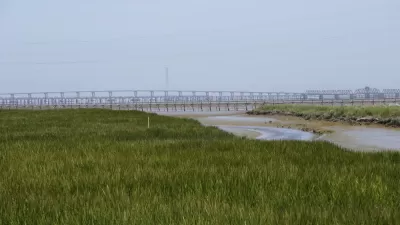Brian Stone of the Georgia Institute of Technology writes about a recent article he co-authored in the Journal of Planning Education and Research.

In the age of climate change, can trees and reflective roofing save lives? This question lies at the heart of a forthcoming study on urban heat management and heat-related mortality in Louisville, Kentucky. Found to rank among the most rapidly warming cities in the United States, Louisville has been heating up at a rate five times greater than that of the planet as a whole over the last several decades. A rapid rate of warming across all large U.S. cities holds significant consequences for human health, with the U.S. Global Change Research Program projecting an increase in annual heat-related deaths of more than 9,000 in U.S. cities by 2030—a seven-fold increase that, if realized, would elevate heat-related mortality to the most rapidly rising cause of the death in the United States (USGRP 2016; Schwartz et al. 2015).
Urban heat management is an emerging field of planning through which municipal governments seek to lessen the intensity and duration of heat exposure through strategies that reduce the urban heat island (UHI) effect—the widely observed phenomenon through which cities exhibit higher temperatures than nearby rural areas. In this study, we model the extent to which urban greening strategies, such as street trees and green roofs, alone and in combination with cool roofing strategies, can reduce the intensity of outdoor heat exposure. We then make use of neighborhood temperature data to estimate how many residents are likely to succumb to heat-related mortality during the summer months. We rely on a previous study associating heat-related mortality in Louisville with temperature to inform our estimates of how many lives could be saved by urban heat management strategies.
As detailed in the study, we found heat management strategies to have a significant cooling effect across Louisville. A combination of urban greening and cool roofing strategies yielded reductions in average summer afternoon temperatures of more than 2°F in many neighborhoods. For single hot afternoons, cooling benefits in excess of 5°F were found, suggesting the potential to reduce the UHI effect by 50% or more in heavily developed zones (typical UHI intensities range from 2 to 10°F in most US cities).
The implications of these modeled reductions in temperature for public health were significant. Overall, we estimated the number of heat-related deaths in Louisville to be more than 50 in a single summer—exceeding the average number of deaths from hurricanes each year across the United States as a whole. Following the implementation of greening and cool roofing strategies in urban core neighborhoods, heat-related mortality was reduced by 22%, suggesting urban heat management programs hold the potential not only to lower ambient temperatures but to save lives in cities as they warm from climate change. A new class of climate adaptation plans—plans focused on managing heat through changes to the built environment—provide an essential complement to established heat wave management strategies, such as early warning systems and the provision of cooling centers. In this sense, the design of the city carries with it the potential to modify the weather—a potential that must be realized to manage the rising threat of extreme heat to human health.
References
Schwartz, J., Lee, M., Kinney, P., Yang, S., Mills, D., Sarofim, M., Jones, R., Streeter, R., Juliana, A., Peers, J., Horton, R. 2015. Projections of temperature-attributable premature deaths in 209 U.S. cities using a cluster-based Poisson approach. Environmental Health, 14. USGCRP, 2016.
The Impacts of Climate Change on Human Health in the United States: A Scientific Assessment. Crimmins, A., J. Balbus, J.L. Gamble, C.B. Beard, J.E. Bell, D. Dodgen, R.J. Eisen, N. Fann, M.D. Hawkins, S.C. Herring, L. Jantarasami, D.M. Mills, S. Saha, M.C. Sarofim, J. Trtanj, and L. Ziska, Eds. U.S. Global Change Research Program, Washington, DC, 312 pp.

Maui's Vacation Rental Debate Turns Ugly
Verbal attacks, misinformation campaigns and fistfights plague a high-stakes debate to convert thousands of vacation rentals into long-term housing.

Planetizen Federal Action Tracker
A weekly monitor of how Trump’s orders and actions are impacting planners and planning in America.

In Urban Planning, AI Prompting Could be the New Design Thinking
Creativity has long been key to great urban design. What if we see AI as our new creative partner?

King County Supportive Housing Program Offers Hope for Unhoused Residents
The county is taking a ‘Housing First’ approach that prioritizes getting people into housing, then offering wraparound supportive services.

Researchers Use AI to Get Clearer Picture of US Housing
Analysts are using artificial intelligence to supercharge their research by allowing them to comb through data faster. Though these AI tools can be error prone, they save time and housing researchers are optimistic about the future.

Making Shared Micromobility More Inclusive
Cities and shared mobility system operators can do more to include people with disabilities in planning and operations, per a new report.
Urban Design for Planners 1: Software Tools
This six-course series explores essential urban design concepts using open source software and equips planners with the tools they need to participate fully in the urban design process.
Planning for Universal Design
Learn the tools for implementing Universal Design in planning regulations.
planning NEXT
Appalachian Highlands Housing Partners
Mpact (founded as Rail~Volution)
City of Camden Redevelopment Agency
City of Astoria
City of Portland
City of Laramie






























